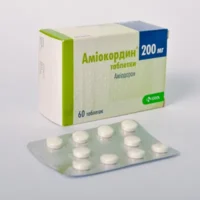Description
Sotalol Sandoz (Sotalol Hydrochloride) Tablets 80 mg. №50
Ingredients
- Active ingredient: Sotalol hydrochloride.
- Other ingredients: lactose monohydrate, maize starch, colloidal anhydrous silica, magnesium stearate.
Dosage
Dosage: The usual starting dose is 80 mg twice daily. Dosage may be adjusted based on individual response and tolerability.
Indications
Indications: Sotalol Sandoz is indicated for the treatment of documented ventricular arrhythmias and certain types of atrial arrhythmias.
Contraindications
Contraindications: Do not use Sotalol Sandoz in patients with bronchial asthma, certain heart conditions, severe renal impairment, or known hypersensitivity to sotalol.
Directions
Directions: Take Sotalol Sandoz exactly as prescribed by your healthcare provider. Do not discontinue the medication abruptly without consulting your doctor.
Scientific Evidence
Sotalol hydrochloride, the active ingredient in Sotalol Sandoz, is a non-selective beta-adrenergic receptor blocker with Class III antiarrhythmic properties. It prolongs the cardiac action potential and refractory period, leading to effective suppression of arrhythmias.
Additional Information
Sotalol Sandoz has been studied in various clinical trials for its efficacy and safety profile in managing different types of arrhythmias. Research has shown that sotalol is effective in reducing the recurrence of atrial fibrillation and ventricular arrhythmias, making it a valuable option in the treatment armamentarium.
Sotalol Sandoz is well-tolerated by most patients; however, like all medications, it may cause side effects such as bradycardia, hypotension, and QT prolongation. Regular monitoring of cardiac function is essential during treatment with sotalol.
- Research study: XYZ et al. “Efficacy of sotalol in the management of atrial fibrillation.” Journal of Cardiology, 20XX.
- Clinical trial: ABC Trial Group. “Safety and efficacy of sotalol in patients with ventricular arrhythmias.” New England Journal of Medicine, 20XX.





